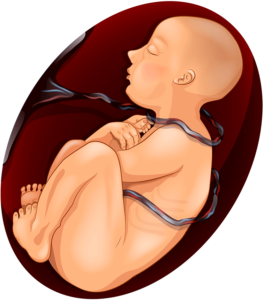Birth Injuries Caused by Nuchal Cord / Umbilical Cord Entrapment
The umbilical cord carries oxygenated blood and nutrients from the placenta to the child during pregnancy. The cord consists of one vein and two arteries, and serves as the child’s lifeline.

Umbilical Cord Strangulation
Unfortunately, in some cases, the umbilical cord can become tangled around the child’s neck and pose a serious risk of fetal asphyxia and and irreversible brain damage. This is referred to as a “nuchal cord.”
It’s estimated that a nuchal cord occurs in about 15 to 34 percent of all childbirths. While most instances of nuchal cord do not necessarily require emergency surgery or intervention, once medical professionals are aware of the issue, your child’s fetal distress signals should be closely monitored at every step—and especially during labor.
A nuchal cord can and should be detected via ultrasound monitoring during any prenatal checkups, as well as during labor and delivery. Failing to identify, monitor, and mitigate any complications of a nuchal cord could be considered medical malpractice.
Risk Factors for Nuchal Cord
Typically, the umbilical cord floats loosely in the amniotic sac for the duration of the pregnancy. In some special pregnancies (such as when there is more than one baby in the womb, or if the baby is too big on account of gestational diabetes), movement can cause the cord to be entangled around the child, potentially forming a loose knot around its neck. This problem is usually exacerbated by the birthing process due to the push and pulling involved, further constricting the child’s blood flow and leading to fetal asphyxia.
Oxygen deprivation, even for a few minutes, can lead to permanent brain damage in the child which can develop into cerebral palsy. Doctors and nurses are tasked with identifying a nuchal cord formation during pregnancy, and a failure to properly monitor the child’s distress signals or take preventative measures (such as scheduling a C-section delivery) could open the doctor up to a medical malpractice claim.
In the most-severe cases, a nuchal cord can result in severe brain damage or the death of the child. Meconium aspiration syndrome is a common complication of a nuchal cord, which can result in fecal matter being introduced to the child’s lungs. Fetal acidosis (the presence of too much acid in the baby’s blood) is another potential health risk which can affect oxygen intake, leading to hypoxia and brain cell death.
Preventing Nuchal Cord Birth Injuries
It is important to understand that nuchal cord complications can and should be prevented, regardless of whether or not they are due to a random event or a hereditary disposition.
Doctors owe patients a “duty of care” to minimize and mitigate any known risks to the child and mother. If they fail in this duty and a someone is seriously injured as a result, the victim (or their family) may be able to recover money damages through a birth injury claim or lawsuit.
Click here to learn more about what constitutes medical malpractice in relation to a birth injury.
